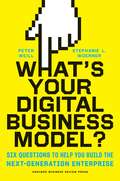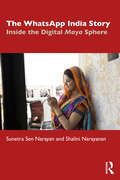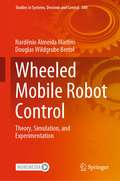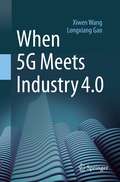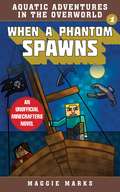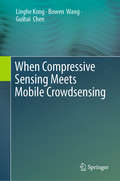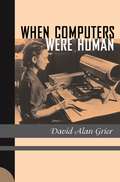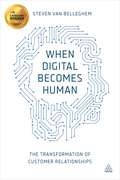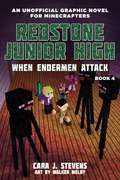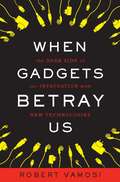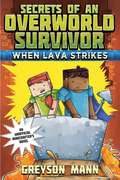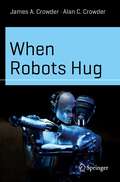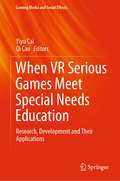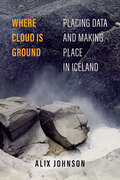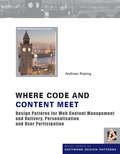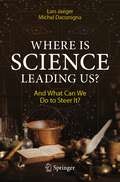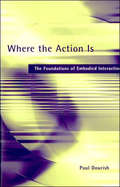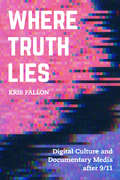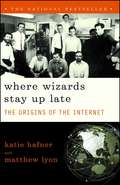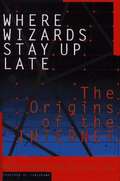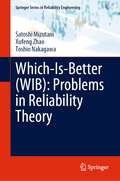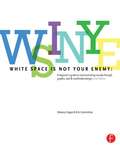- Table View
- List View
What's Your Digital Business Model?: Six Questions to Help You Build the Next-Generation Enterprise
by Peter Weill Stephanie Woerner<p>What is your digital business model? While many leaders of companies recognize the threat from digital--and the potential opportunity--they lack a common language or a compelling framework to help them assess it and, more importantly, to direct them. They don't know how to think about their digital business model. In this probing and practical book, Peter Weill and Stephanie Woerner provide much-needed tools, self-assessments, motivating examples, and key financial analyses of where the profits will likely be made. <p>Based on five years of study at the MIT Center for Information Systems Research, the book provides a powerful yet simple framework that has been field-tested globally with more than a dozen senior management teams. The authors found that digitization is moving companies' business models on two dimensions: from value chains to digital ecosystems, and from a fuzzy understanding of the needs of end customers to a sharper one. Looking at these dimensions in combination results in four distinct business models, each with different capabilities: (1) Supplier, (2) Omni-channel, (3) Modular Producer, and (4) Ecosystem Driver. The framework helps companies clarify where they are currently in an increasingly digital business landscape and highlights what's needed to move toward another, higher-value digital business model. <p>In meeting the growing challenge to "go digital," this smart book will help you grapple with the threats, respond to the opportunities, and create winning digital strategies.</p>
The WhatsApp India Story: Inside the Digital Maya Sphere
by Sunetra Sen Narayan Shalini NarayananWhatsApp is used by over half a billion people in India today in all fields – in business, corporate and informal sectors, in government, for education and among friends, families and acquaintances. This book critically explores the social messaging app’s rapid expansion in India and its growing influence and looks at whether, as a form of horizontal communication, it poses a challenge to more traditional structures of communication. The book examines WhatsApp’s spread in the personal and professional lives of Indians and the myriad ways in which people in India are using the app in social and business interactions, including among people living with disabilities. Using case studies, interviews, surveys and in-depth research, it analyses key aspects of WhatsApp’s massive popularity and its impact on how people communicate. It also explores its impact on the psycho-social dynamics in India, including the dissemination of fake news and politically motivated content, and the consequent need for media regulation in the country. One of the first books to analyse the pervasiveness of WhatsApp and social media apps in different areas of Indian society, this book will be of interest to scholars and students of media studies, communication studies, digital media, cultural studies, cyberculture studies, sociology and social policy and media law.
Wheeled Mobile Robot Control: Theory, Simulation, and Experimentation (Studies in Systems, Decision and Control #380)
by Nardênio Almeida Martins Douglas Wildgrube BertolThis book focuses on the development and methodologies of trajectory control of differential-drive wheeled nonholonomic mobile robots. The methodologies are based on kinematic models (posture and configuration) and dynamic models, both subject to uncertainties and/or disturbances. The control designs are developed in rectangular coordinates obtained from the first-order sliding mode control in combination with the use of soft computing techniques, such as fuzzy logic and artificial neural networks. Control laws, as well as online learning and adaptation laws, are obtained using the stability analysis for both the developed kinematic and dynamic controllers, based on Lyapunov’s stability theory. An extension to the formation control with multiple differential-drive wheeled nonholonomic mobile robots in trajectory tracking tasks is also provided. Results of simulations and experiments are presented to verify the effectiveness of the proposed control strategies for trajectory tracking situations, considering the parameters of an industrial and a research differential-drive wheeled nonholonomic mobile robot, the PowerBot. Supplementary materials such as source codes and scripts for simulation and visualization of results are made available with the book.
When 5G Meets Industry 4.0
by Longxiang Gao Xiwen WangSince the 1980s, mobile communication has undergone major transitions from 1G to 4G, at a rate of roughly one generation per decade. And the next upgrade is set to come soon, with 5G heralding a new era of large-bandwidth Internet, and a multi-connection, low-latency Internet of Everything.5G technology will be the standard for next-generation mobile Internet, and it will not only enhance the individual user’s experience, but also provide technical support for artificial-intelligence-based applications, such as smart manufacturing, smart healthcare, smart government, smart cities and driverless cars. As a result, 5G is regarded as the “infrastructure” of the industrial Internet and artificial intelligence and both China and the United States are striving to become the 5G leader and spearhead this new generation of international mobile communication standards. Though trade tensions between China and the United States continue to escalate, with products ranging from soybeans to mobile phones and automobiles being affected, 5G technology may be the true cause of trade wars between the world’s top two economies.In short, 5G will change not only society, but also international trade patterns. This book describes various 5G scenarios, changes and values; explains the standards, technologies and development directions behind 5G; and explores new models, new formats and new trends in 5G-based artificial intelligence.
When a Phantom Spawns: An Unofficial Minecrafters Novel (Aquatic Adventures in the Overworld #1)
by Maggie MarksA brand-new series about the underwater world of Minecraft! Brothers Mason and Asher have only ever known the comfort of dry land in the Overworld. But when a terrifying shipwreck leaves them stranded, their new friend Luna urges them to safe haven—underwater. In each story of the all-new series for Minecrafters, Aquatic Adventures in the Overworld, this unlikely trio must make the choice of staying in the world they know best and risk death, or voyaging into an unknown world where anything could happen. Follow their journey as Mason, Asher, and Luna face incredible obstacles and discover strength they never knew they had in Aquatic Adventures in the Overworld. In their first aquatic adventure, Mason and his brother, Asher, wake to find themselves shipwrecked on a deserted beach. Where are they? How’d they get here? And how will they survive? They’ve lost their map, and now Mason is losing sleep, too. Are those phantoms swirling overhead, waiting to strike? A new friend, Luna, urges the brothers to follow her underwater to the safety of the ocean floor—before it’s too late. . .
When Compressive Sensing Meets Mobile Crowdsensing
by Linghe Kong Bowen Wang Guihai ChenThis book provides a comprehensive introduction to applying compressive sensing to improve data quality in the context of mobile crowdsensing. It addresses the following main topics: recovering missing data, efficiently collecting data, preserving user privacy, and detecting false data.Mobile crowdsensing, as an emerging sensing paradigm, enables the masses to take part in data collection tasks with the aid of powerful mobile devices. However, mobile crowdsensing platforms have yet to be widely adopted in practice, the major concern being the quality of the data collected. There are numerous causes: some locations may generate redundant data, while others may not be covered at all, since the participants are rarely systematically coordinated; privacy is a concern for some people, who don’t wish to share their real-time locations, and therefore some key information may be missing; further, some participants may upload fake data in order to fraudulently gain rewards. To address these problematic aspects, compressive sensing, which works by accurately recovering a sparse signal using very few samples, has proven to offer an effective solution.
When Computers Were Human
by David Alan GrierBefore Palm Pilots and iPods, PCs and laptops, the term "computer" referred to the people who did scientific calculations by hand. These workers were neither calculating geniuses nor idiot savants but knowledgeable people who, in other circumstances, might have become scientists in their own right. When Computers Were Human represents the first in-depth account of this little-known, 200-year epoch in the history of science and technology. Beginning with the story of his own grandmother, who was trained as a human computer, David Alan Grier provides a poignant introduction to the wider world of women and men who did the hard computational labor of science. His grandmother's casual remark, "I wish I'd used my calculus," hinted at a career deferred and an education forgotten, a secret life unappreciated; like many highly educated women of her generation, she studied to become a human computer because nothing else would offer her a place in the scientific world. The book begins with the return of Halley's comet in 1758 and the effort of three French astronomers to compute its orbit. It ends four cycles later, with a UNIVAC electronic computer projecting the 1986 orbit. In between, Grier tells us about the surveyors of the French Revolution, describes the calculating machines of Charles Babbage, and guides the reader through the Great Depression to marvel at the giant computing room of the Works Progress Administration. When Computers Were Human is the sad but lyrical story of workers who gladly did the hard labor of research calculation in the hope that they might be part of the scientific community. In the end, they were rewarded by a new electronic machine that took the place and the name of those who were, once, the computers.
When Digital Becomes Human
by Steven Van BelleghemIn an age when customers have access to vast amounts of data about a company, its product and its competitors, customer experience becomes increasingly important as a sustainable source of competitive advantage. But success doesn't just rely on digital engagement and excellence, but also on combining a digital-first attitude with a human touch. In When Digital Becomes Human, Steven Van Belleghem explores and explains the new digital relationships. Packed with global examples from organizations that have successfully transformed their customer relationships, such as Amazon, Toyota, ING, Coolblue, Nike and Starbucks, When Digital Becomes Human presents a clear model that companies can easily implement to integrate an emotional layer into their digital strategy. This guide to combining two of a business's most important assets - its people and its digital strengths - covers the latest issues in digital marketing and customer experience management, including omnichannel and multichannel experiences, big data and predictive analytics, privacy concerns, customer collaboration (ie crowdsourcing) and more.
When Endermen Attack (Redstone Junior High #4)
by Cara J. StevensWinter has come to Redstone Junior High once again, and with it comes holiday celebrations, snowball combat practice, and loads of outdoor fun. But even though the threat of Smite and his henchmen has passed, a new, sinister force lurks in the dark hallways of the school. Strange blocks begin to appear in random places throughout the school, and students have been hearing eerie sounds coming from its abandoned corridors. Pixel, Sky, and Umal team up to figure out what’s tormenting their school and why. <p><p> To make matters worse, Tina and her followers are determined to work against Pixel. What follows is a griefing war that spares no one—not even the teachers or Principal Redstone. As the kids discover more about the lanky creatures who are terrorizing their school, it becomes painfully clear that they must put aside their differences to unite against a common enemy. Will a mob invasion actually bring the students together, or will Redstone Junior High remain haunted forever?
When Gadgets Betray Us: The Dark Side of Our Infatuation With New Technologies
by Robert VamosiWriting in plain language for general readers, Vamosi, a computer security analyst and a contributing editor at PCWorld, explains what we're really signing up for when we log in and reveals the secret lives of our electronic devices, offering a commonsense approach for protecting ourselves. The book is about hardware hacking and new kinds of identity fraud: how our mobile phone conversations can be intercepted, how our credit cards and driver's licenses can be copied at a distance. The author travels from the streets of New York and LA to Johannesburg and Berlin, to talk to people who have experienced firsthand how gadgets can betray us and to examine the effects of technology in the Third World. He recommends the addition of basic authentication and strong encryption to most hardware to reduce the vulnerabilities described in the book, but notes that hardware manufacturers have so far shown little interest in securing their gadgets. Annotation ©2011 Book News, Inc. , Portland, OR (booknews. com)
When Lava Strikes: An Unofficial Minecrafters Novel (Secrets of an Overworld Survivor #2)
by Greyson Mann Grace SandfordWhen Will and Mina discover an abandoned mine shaft, they quickly plan a treasure hunt. The two friends dream of the riches they’ll unearth together and can’t wait to get started, but they quickly discover that they very different ideas about what treasure is! Torn between searching for mobs and potion supplies and seeking out the chest at the heart of the mine, the duo is on the verge of splitting up.But then a trio of treasure hunters challenge Will and Mina, and a poorly aimed pickaxe puts everyone in the mine in danger. As the chambers around them fill with lava and their hunt for treasure becomes a fight for survival, can Will and Mina put their differences aside and work together to escape with their lives?Every chapter of this second installment in the Secrets of an Overworld Survivor chapter book series is packed with adventure-perfect for introducing young gamers to reading!Sky Pony Press, with our Good Books, Racehorse and Arcade imprints, is proud to publish a broad range of books for young readers-picture books for small children, chapter books, books for middle grade readers, and novels for young adults. Our list includes bestsellers for children who love to play Minecraft; stories told with LEGO bricks; books that teach lessons about tolerance, patience, and the environment, and much more. While not every title we publish becomes a New York Times bestseller or a national bestseller, we are committed to books on subjects that are sometimes overlooked and to authors whose work might not otherwise find a home.
When Robots Hug (Science and Fiction)
by James A. Crowder Alan C. CrowderBy 2027, it had been seven years since the scientists’ sea-changing research on artificial psychology and robotics. The work debuted around the same time as Large Language Model Chatbots, and the power of the integration of the two technologies put many industries in a tailspin. The commercial and defense industries especially were still scrambling to regulate their use in research and universities. The sought-after scientists signed with DARPA to build reliable and secure AI entities, but the agency grew fearful of the technology’s power and ultimately decided it was too dangerous to bring to market and demanded the scientists destroy the work. The researchers couldn’t bring themselves to discard 20 years of research, so instead sent the entities to various research labs around the world. But unbeknownst to them, each AI-entity embraced its new home, growing, adapting, evolving, and ultimately connecting beyond what the researchers could envision. In the end, as the scientists catch up to each one, they realize the entities have discovered a very human means of interacting: the power of physical contact; and not physical contact between humans and technology, but physical contact between robotic entities. And with this discovery, the entities join forces to only grow stronger. This development ushers in a new paradigm where the difference between AI-entities and human entities becomes less and less discernible. All the AI and robotic science featured in the book is real; the story line is fictional, but with how fast innovation moves, it’s not hard to envision.
When the Press Fails: Political Power and the News Media from Iraq to Katrina
by W. Lance Bennett Regina G. Lawrence Steven LivingstonDrawing on revealing interviews with Washington insiders and analysis of content from major news outlets, the authors illustrate the media unilaterally supported White House whenever oppositional voices elsewhere in government fall silent.
When VR Serious Games Meet Special Needs Education: Research, Development and Their Applications (Gaming Media and Social Effects)
by Yiyu Cai Qi CaoThis book presents selected research and development on virtual reality (VR) and serious games (SG) applications to assist children with Autism Spectrum Disorder (ASD) in their learning of different skills. Children with ASD have challenges to learn skills of learning, living, and working, due to their cognitive and behavioral limitations. The authors and their research teams of this book have many years’ research experience developing innovative and interactive VR and SG technology for the special needs education. More specifically, several VR serious games are designed to train children with ASD on learning skill, life skill, and job skill. Such games are often developed based on the needs of special education and used by special needs schools in Singapore. This book is a useful resource for students, scholars, and designers of learning material who want to embrace VR and SG for children with ASD.
When You Find Out the World Is Against You: And Other Funny Memories About Awful Moments
by Kelly Oxford“Kelly is part geek, part freak. When You Find Out The World Is Against You shows us ourselves: our sensitivities, our awkward moments, our strange desires. She takes us through summer camp, dating, rape culture, Trump, death . . . Kelly Oxford c’est moi.” — James Franco“Two things I’m grateful for: how imperfect Kelly Oxford is at life and decision-making, and how terrific she is at writing about what a goddamn mess she is.” — Patton Oswalt“Kelly Oxford’s writing is hilarious and fearless. She’s the badass Canadian sister I never had.” — Mindy Kaling“I have worshipped the mind of Kelly Oxford for eons. Kelly Oxford’s concise, whip-smart observations feel eerily universal. When You Find Out the World is Against You shows that there is something to be learned from even the most absurd or devastating moments of life.” — Jill Soloway“Kelly Oxford is a beautiful writer. She finds beauty in the mundane and humor in everyday eccentricities. She is our present-day, funny Joan Didion.” — Gia Coppola
Where Cloud Is Ground: Placing Data and Making Place in Iceland (Atelier: Ethnographic Inquiry in the Twenty-First Century #11)
by Alix JohnsonWhere Cloud Is Ground offers an ethnography of the international data storage industry and an inquiry into the relationship between data and place. Based in Iceland, which is fast becoming a hot spot for data centers—facilities where large quantities of data are processed and stored—the book traces the fraught work of siting data’s material manifestations in relation to landforms and earth processes, local politics, national narratives, and still-open questions of spatial justice and sovereignty. Doing so, it unsettles techno-utopian ideals of connectivity and offers a window into what it means to live with our data, in a place where more and more data now lives.
Where Code and Content Meet
by Andreas RuepingA practical go-to reference for Web developers programming custom software for Web sitesMost advanced Web sites or Web platforms have specific requirements that go beyond standard functionality; to meet such requirements, it's often necessary to develop custom software. This is the point where code and content meet, and where this book begins. Where Code and Content Meet presents a collection of real-world, tried and tested patterns that address content-related aspects of custom software development for advanced Web sites or platforms.Mined from a series of successful Web projects, the patterns represent collected expertise of designers from several software development teams and serve as a practical guide to designing your own content-related custom components for your Web project. The patterns are independent of specific tools and technologies, and focus on non-functional requirements, with the overall goal of defining sustainable software architecture.Presents a collection of tried and tested software patterns mined from a series of successful Web projectsIncludes checklists for managing Web projects and real-world patterns from PLoP conferencesIllustrates use of software patterns through a case study that runs throughout the book and gradually evolves as the patterns are applied to it, one by oneCovers content modeling and content organization, navigation, findability, personalization, and user participationBy employing the software patterns included in Where Code and Content Meet, you'll learn how to program custom software faster and more efficiently.
Where Is Science Leading Us?: And What Can We Do to Steer It?
by Lars Jaeger Michel DacorognaThis book charts the evolution of the sciences and technologies that have shaped our modern age like nothing else in the last 60 years. As well as describing many exciting developments, it will also highlight the challenges and dangers of the technologies that have emerged from them. While science and technology have brought about enormous and often astonishing improvements in our quality of life, they have often also brought with them considerable risks, including the risk of human extinction. We place particular emphasis on the aspects that directly impact us as human beings: Artificial Intelligence (AI), enhancements of our brains/minds through innovative neuro-technologies, and the integration of nanotechnology into our bodies for early disease detection and elimination. What philosophical implications arise from these transformations? Authored by two theoretical physicists who are also experts in economics and capital markets - a rather rare combination - the book will explain the developments of modern science and the resulting technologies. It also examines the current state of play and emerging developments in a manner accessible to non-scientists. Based on their own experience and the analysis, the authors also propose ways in which science can progress more harmoniously in future.
Where the Action Is: The Foundations of Embodied Interaction (The\mit Press Ser.)
by Paul DourishComputer science as an engineering discipline has been spectacularly successful. Yet it is also a philosophical enterprise in the way it represents the world and creates and manipulates models of reality, people, and action. In this book, Paul Dourish addresses the philosophical bases of human-computer interaction. He looks at how what he calls "embodied interaction"—an approach to interacting with software systems that emphasizes skilled, engaged practice rather than disembodied rationality—reflects the phenomenological approaches of Martin Heidegger, Ludwig Wittgenstein, and other twentieth-century philosophers. The phenomenological tradition emphasizes the primacy of natural practice over abstract cognition in everyday activity. Dourish shows how this perspective can shed light on the foundational underpinnings of current research on embodied interaction. He looks in particular at how tangible and social approaches to interaction are related, how they can be used to analyze and understand embodied interaction, and how they could affect the design of future interactive systems.
Where Truth Lies: Digital Culture and Documentary Media after 9/11
by Kris FallonA free open access ebook is available upon publication. Learn more at www.luminosoa.org. This boldly original book traces the evolution of documentary film and photography as they migrated onto digital platforms during the first decades of the twenty-first century. Kris Fallon examines the emergence of several key media forms—social networking and crowdsourcing, video games and virtual environments, big data and data visualization—and demonstrates the formative influence of political conflict and the documentary film tradition on their evolution and cultural integration. Focusing on particular moments of political rupture, Fallon argues that the ideological rifts of the period inspired the adoption and adaptation of newly available technologies to encourage social mobilization and political action, a function performed for much of the previous century by independent documentary film. Positioning documentary film and digital media side by side in the political sphere, Fallon asserts that "truth" now lies in a new set of media forms and discursive practices that implicitly shape the documentation of everything from widespread cultural spectacles like wars and presidential elections to more invisible or isolated phenomena like the Abu Ghraib torture scandal or the "fake news" debates of 2016.
Where Wizards Stay Up Late: The Origins Of The Internet
by Katie Hafner Matthew LyonTwenty five years ago, it didn't exist. Today, twenty million people worldwide are surfing the Net. Where Wizards Stay Up Late is the exciting story of the pioneers responsible for creating the most talked about, most influential, and most far-reaching communications breakthrough since the invention of the telephone. In the 1960's, when computers where regarded as mere giant calculators, J.C.R. Licklider at MIT saw them as the ultimate communications devices. With Defense Department funds, he and a band of visionary computer whizzes began work on a nationwide, interlocking network of computers. Taking readers behind the scenes, Where Wizards Stay Up Late captures the hard work, genius, and happy accidents of their daring, stunningly successful venture.
Where Wizards Stay Up Late: The Origins of the Internet
by Katie Hafner Matthew Lyon"A little more than twenty-five years ago, computer networks did not exist anywhere - except in the minds of a handful of computer scientists. In the late 1960s, the Defense Department's Advanced Research Projects Agency funded a project to create computer communication among its university-based researchers. The experiment was inspired by J. C. R. Licklider, a brilliant scientist from MIT. At a time when computers were generally regarded as nothing more than giant calculators, Licklider saw their potential as communications devices." "Where Wizards Stay Up Late is the story of the small group of researchers and engineers whose invention, daring in its day, became the foundation for the Internet. With ARPA's backing, Licklider and others began the quest for a way to connect computers across the country." "In 1969, ARPA awarded the contract to build the most integral piece of this network - a computerized switch called the Interface Message Processor, or IMP - to Bolt Beranek and Newman (BBN), a small Cambridge, Massachusetts, company. A half-dozen engineers at BBN, who called themselves the IMP Guys, knew it was possible to do what larger companies - including AT&T and IBM - had dismissed as impossible. But making computer networking possible required inventing new technologies. Working around the clock, the IMP Guys met a tight deadline, and the first IMP was installed at UCLA nine months after the contract award." "A nationwide network called the ARPANET grew from four initial sites. Protocols were developed, and along the way a series of accidental discoveries were made, not the least of which was e-mail. Almost immediately, e-mail became the most popular feature of the Net and the "@" sign became lodged in the iconography of our times. The ARPANET continued to grow, then merged with other computer networks to become today's Internet. In 1990, the ARPANET itself was shut down, fully merged by then with the Internet it had spawned.
Which-Is-Better (Springer Series in Reliability Engineering)
by Satoshi Mizutani Xufeng Zhao Toshio NakagawaThis is the first book on the Which-Is-Better (WIB) Problem. These are questions that in daily life include such as “Which is larger, younger and stronger?". The main objective of this book is summarizing WIB Problems in maintenance and reliability theory. Optimal policies of replacement first, last and overtime are derived and compared theoretically and numerically, and WIB policies are determined. Furthermore, the reliability properties of parallel and standby systems are compared, and WIB system is determined. These WIB Problems are applied to shock and damage models and backup and checkpoint models of computer systems.
White-Collar Crime Online: Deviance, Organizational Behaviour and Risk
by Petter Gottschalk Christopher HamertonThis initiating monograph provides the first thorough examination of the concept of white-collar crime online. Applying an offender-based perspective which considers the central role of convenience, it seeks to inform, improve and develop the current literature on cybercrime, whilst paying particular attention to its founding category within criminology. It argues that white-collar crime has receded from criminological perspectives on cybercrime in recent years and that a detailed, rich re-assessment of white-collar crime in contemporary digital societies is needed. Following a theoretical introduction, the book develops to discuss, inter alia, implications for corporate reputation, the various organizational roles utilized in mitigating external and internal threats, the unique considerations involved in law enforcement efforts, and likely future directions within the field. White-Collar Crime Online recognises the strong lineage and correlation that exists between the study of white-collar crime and cybercrime. Using convenience theory within a comparative analysis which includes case-studies, the book explores both European and American paradigms, perspectives and models to determine where white-collar crime exists within the contemporary workplace and how this might relate to the ongoing discourse on cybercrime. In doing so it revaluates criminological theory within the context of changing patterns of business, the workplace, social rules, systems of governance, decision making, social ordering and control. White-Collar Crime Online will speak to criminologists, sociologists and professionals; including those interested in cyber-security, economics, technology and computer science.
White Space Is Not Your Enemy: A Beginner's Guide To Communicating Visually Through Graphic, Web And Multimedia Design
by Kim Golombisky Rebecca HagenDesigning a website or brochure without an art background? Then step away from the computer and read this engaging, conversational introduction to visual communications first. Written for the beginner, White Space is Not Your Enemy, Second Edition, is a practical graphic design and layout guide that introduces the concepts and practices necessary for producing effective visual communication across a variety of formats--from web to print. <P><P> This beautifully illustrated, full-color book covers all of the basics to help you develop your eye and produce evocative designs that work. Topics include: <P> * What is design? <P> * Pre-design research and brainstorming. <P> * The "works-every-time layout" and "13 layout sins." <P> * The elements and principles of design. <P> * Layouts for impact. <P> * Getting along with type. <P> * Choosing and using color. <P> * Working with photos and illustrations. <P> * Intros to infographics, storyboarding and multimedia components. <P> * Output for the web and print. <P> Visit www. whitespacedesignbook. com for additional supporting materials.
